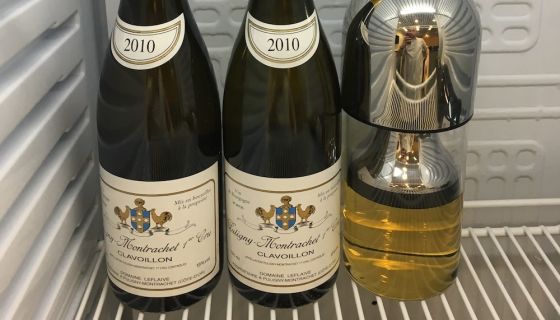There are dozens of wine-preservation gadgets on the market, most of which don’t work especially well. The big game-changer of recent years was the Coravin, an innovative gadget that has been widely adopted by wine professionals and consumers alike as the most effective way of preserving and pouring wine from a sealed bottle. However, it can be an expensive device to run, requiring a ready supply of gas-cartridge refills.
An apparent solution to the problem emerged in 2017, after five years of development: the eto was a decanter and preserver, promising to protect wine from oxygen without the need for gas.
I tested a prototype in June 2017 and was totally convinced by the results: through smart design involving a plunger pushed down onto the surface of the wine (a bit like a cafetière), this device was able to keep an opened bottle of wine fresh for seven days, so that I was unable to tell the difference between the eto sample and a freshly opened bottle.
I immediately purchased two etos through their Kickstarter campaign, at an earlybird price of £109 for two, plus £5 delivery. The campaign was fully funded in 32 hours, and a subsequent Indiegogo campaign was hugely successful. Together, the eto raised £1,170,290 in crowdfunded capital, which presumably makes up for the capital that has been omitted from the product’s name.
The original estimated delivery date was February 2018, but the production process soon encountered problems. By October 2017, the challenges were clearly going to delay manufacturing – but to the inventors' credit, they were brutally honest throughout, and were clearly committed to producing a finished product that delivered on the quality promised.
Last month, my pair of etos finally arrived and I was immediately keen to repeat my original experiment and test the effectiveness of the production-line eto. Here's my unboxing video from Instagram.
At first glance, it’s a handsome item, well packaged and with the quality of materials that justifies the price. For this first batch of etos, an improved replacement seal was provided. Unscrewing the glass base from the metallic top requires a little force, and replacing the plunger is fiddly at first, but by the second or third time, I was used to it.
Duly prepared, the experiment was set up at the residential seminar for Master of Wine students in the last week of January where I had a captive audience of MWs as guinea pigs. On Monday afternoon, I decanted half a bottle of Dom Leflaive, Clavoillon Premier Cru 2010 Puligny-Montrachet into the eto. I recorked the remaining half bottle and placed them both in the fridge, alongside an unopened, control bottle. I then repeated this process for a bottle of Crystallum, Peter Max Pinot Noir 2016 Western Cape, leaving these two bottles at room temperature.
Four days later, on Friday afternoon, two blind tastings for each wine were carried out. The first was a triangle tasting involving two glasses of eto-stored wine and one from a freshly opened bottle. The objective here was to see whether wine from the freshly opened bottle could be distinguished from the wine stored in the eto; in other words, whether the eto effectively preserved the wine.
The second experiment involved one glass from the eto, one glass from a freshly opened bottle and third glass from the half-empty bottle that had been left with the cork/screwcap replaced. In this case, the objective was to see whether the eto performed better than a half-opened bottle, and as well as the freshly opened bottle – again, to test its preservative qualities.
Seven MWs tasted the wines blind and in isolation, and I collated the results. Compared with my first experience with the eto, the findings are less conclusive – although there are some very useful observations.
RESULTS
The first observation is that refrigeration seems to be an essential element of the eto system. For the triangle test of the red wine, stored at room temperature, 100% identified the fresh bottle and in the three-way test, 85% identified the fresh bottle. When tasting the wines myself, it was very obvious that the eto-stored wine had oxidised at the same rate as the wine in the half-empty bottle.
For the white wine, however, the results were very different. In the triangle test on a refrigerated white, only 29% identified the fresh bottle correctly, suggesting that the difference between the eto-stored wine and a freshly opened bottle is less obvious when refrigerated.
For the three-way test, the results were more confused: 71% thought the opened bottle was fresh; only 29% identified the fresh bottle as such; and 50% thought the eto-stored was the opened bottle. This suggests that there was no strong, obvious difference between the three wines – implying that the eto is no better than a half-open bottle – although that apparently contradicts the results of the triangle test.
There are several factors that could have compromised the results. First, bottle variation in the 2010 Leflaive (which does not have a perfect record for consistency). Second, I did not measure an exact 375 ml pour when decanting into the eto, so varying volumes of wine could have made a difference. Third, there’s a suggestion that over-enthusiastic splashing when initially filling the eto could introduce too much oxygen into the wine, accelerating its degradation even when the eto is plunged and refrigerated. I would have poured more carefully if I had known.
On the other hand, five out of seven MWs couldn’t tell the difference between a top white burgundy that had been stored in an eto for four days when compared with a freshly opened bottle – a small dataset, but nevertheless quite persuasive.
CONCLUSION
Elsewhere online, the eto has met with a generally positive reception: there are threads on Wine Beserkers, Wine-Pages and our own forum in which various experiences are discussed. Many find that a slow, controlled oxidation in the eto at room temperature was entirely beneficial, while others found the preservation qualities to be impeccable a week later. However, there are one or two complaints that oxidative spoilage is developing in an (unrefrigerated) eto-stored wine, as it did with the Pinot Noir I used.
When I originally tested the eto in 2017, I had no reservations about its efficacy; now, after my first experience with the production-line model, I am more cautious. Like any new toy, efficiency of technique will probably improve with repeated usage – and I am certainly not at all discouraged from using my eto to test it further. Especially when Domaine Leflaive Puligny-Montrachet is involved.
















